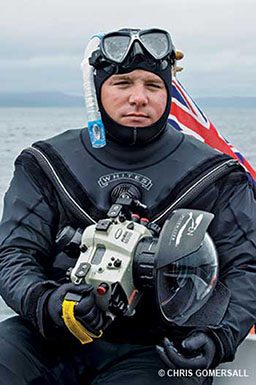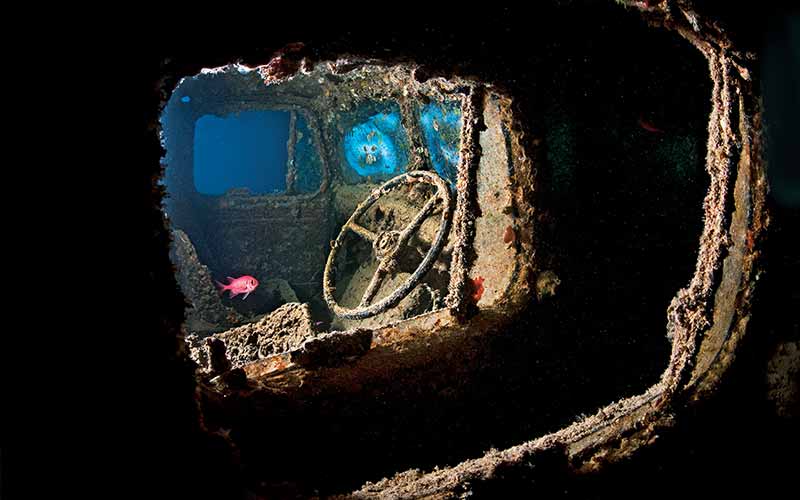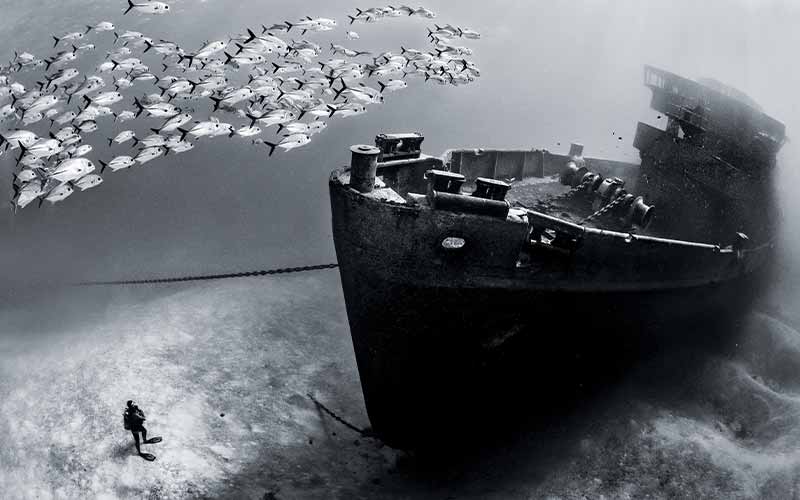“When I’m in the field I’m totally absorbed by it and in awe of the underwater world.”
— Alex Mustard, Ph.D.

Alex Mustard, Ph.D., is among the first prominent underwater photographers to come of age during the digital era. That’s not to say he never shot film; he was an enthusiastic underwater photographer from a very young age. In his teens he always had a camera along on family trips, and when Christmas and birthdays came around some new bit of camera gear was always at the top of his wish list. Today he has a Nikonos RS, a housed Hasselblad and other film cameras sitting unused on a shelf — artifacts of the past — while he marches forward at the cutting edge of new technologies.
Despite Mustard’s early interest in photography, he didn’t initially envision marine photography as his life’s ambition. Throughout childhood his dream was steadfastly rooted in science — marine biology in particular — although he wasn’t completely certain about what being a marine biologist entailed. In his childhood fantasy it was an amorphous vision of traveling the world studying fish and mammals and thereby contributing to the greater good of the world’s oceans. It was that vision that led him to complete a doctoral dissertation on marine pelagic ecology and receive his Ph.D. from the University of Southampton in Great Britain in 2000.
For four years after that he worked as a marine scientist, intently focused on his work. But another muse insistently intervened, and every vacation was a dive trip with the express purpose of taking underwater photographs. Eventually, that dichotomy of passion is what forced him to choose underwater photojournalism over science; there simply wasn’t enough time off from his day job as a marine biologist to go to all the places and shoot all the things that inspired him.
At that time he was in his 20s, single and financially untethered, so when he got a commission in 2004 to collaborate with author Nick Hanna on a book titled The Art of Diving, the choice was made. The only way he could accomplish the necessary travel and image acquisition for the book was to take a giant stride into underwater photography as a career rather than a hobby. His splash has been quite significant in the decade since.

STEPHEN FRINK//I think of you as an innovator in digital underwater image capture. The first images of yours I saw were online — on Wetpixel.com forums about various digital cameras and housings. Have you always been interested in the scientific as well as the artistic side of underwater photography?
*ALEX MUSTARD/ I think my scientific background makes me quite a technical shooter, interested in fully understanding how certain images are made and how the equipment works. That tends to spark my artistic creativity, giving me ideas for fresh images. The new capabilities that digital cameras brought (and continue to bring) to underwater photography were tailor-made for my style of working.
The digital revolution was also very timely for practical reasons; it massively reduced my costs as I was building my portfolio. Starting out as a pro involves balancing tiny budgets, and the fact that I didn’t have to pay for film or processing in 2004 was a big help. Digital workflow advantages helped, too. Some of the places I was going while working on The Art of Diving were quite remote, and knowing I had the shot in the can before we moved on to the next destination was very empowering.

Back then, my kit was a Nikon D100 in a Subal housing. Compared to the cameras I shoot today, the resolution was marginal and the time spent writing to buffer was tedious. But to be in the water exploring new (to me) dive sites and shooting images I could then share online with ease really stimulated my creativity.
SF// You invest a lot of effort in reporting on the newest digital cameras and the various housings used to take them underwater. Many of these reports are extraordinarily detailed and meticulously researched, yet no one is paying you for them. What motivates you to dedicate so much personal bandwidth to equipment reviews?
*AM/ I am curious by nature — the “inquiring scientific mind” — and the scientific method no doubt influences how I approach underwater photography. Take my gear, for example. I have used various Nikon camera bodies as they became available — from the D100 to the D2X, D3 and D700, to my current favorite, the D4 full-frame pro body. I still own and use cropped-sensor cameras, too, because there are lots of things they do better. I guess it depends on what I’m photographing.

Lately I have also been experimenting with Olympus’ two-times-crop mirrorless cameras, whose small size is beneficial in many areas (such as when freediving with pelagics) in the same way the Nikonos V was. The Olympus OM-D has such high image quality that I feel I’m not compromising on the final photograph, and I can simply get the camera places I can’t get my D4.
The reviews come from an almost selfish perspective: The most avid reader of any of my equipment posts is me. But I know our community values them, too — dealers will email me to say they have a customer waiting for my review before they will buy.
Writing reviews also forces me to read the manual, a discipline I know not everyone enjoys. But for me they are real page-turners. Every new feature might reveal a new way for me to make images underwater. A well-known example is the remarkable enhancement in high-ISO performance in recent years, which has transformed what we can do in deep, dark places and at high latitudes. It is not a coincidence that my first trip to Vancouver Island was also my first trip with the Nikon D3.
The reality is that kit is generally very good today, whether it comes from Nikon or Canon, or Hasselblad for that matter. I don’t write the reviews for the manufacturers but for enthusiasts like me. I don’t say everything is wonderful if it’s not; I know if I don’t report accurately people will perceive a bias and simply quit reading.

SF// The last time we crossed paths you were teaching a photo seminar on Grand Cayman. I came away impressed with your preparation of educational visuals and your dedication to your students in the water. Is photo instruction a large part of what you do these days?
*AM/ I wouldn’t want it to become the majority of my travel; I want to remain a photographer first, rather than an educator, but the popularity of my workshops has definitely contributed to growth in that area of my work. I have to admit I love running the events. We work hard, but we have a great laugh, and I find it deeply satisfying to see the improvement in my students and the quality of work they produce. There has rarely been an international underwater photo contest in the last few years in which a photo taken in one of my workshops hasn’t picked up an award.
Typically, I run them for a couple of weeks in places like the Red Sea or Grand Cayman with two groups back to back. I find it works best in locations I know inside and out, places that offer high-quality diving and subject matter with an element of repeatability, so the students can go back and really nail the shots. I suppose it’s the same reason you run seminars in Key Largo. I feel the experience is much better for the students in destinations that I know well, as opposed to places that might be more exciting for me to visit.

SF// Where do you see your career as a marine photographer taking you in the near future?
*AM/ I love all aspects of underwater photography. I am as excited to photograph shipwrecks with their fascinating play of light and texture as I am to photograph fish behaviors. I’ve always been inspired by the marine photographers who can do it all, so I like to maintain a diverse portfolio, and I enjoy the challenge of producing memorable photos in different conditions. My last overseas trip involved a week of shooting only nudibranchs in ice-cold Norwegian water in winter. It’s not exactly the most commercial subject, but it yielded beautiful images, and I learned loads as a photographer. You develop your skills much more deeply by continually challenging yourself rather than just doing the same thing.
I do really like the bread and butter of this job. I am happy with how it is working out financially, and I find the turnaround in magazine work — with its short intervals between shooting stories and seeing them published — very motivating. I am not looking for a big career change — more of the same, please! There are so many things I have yet to see and shoot. I’ve not yet swum with a whale or dived under ice. I am certainly not bored.

For the past few years I have been involved in a project in the UK called 2020VISION, which is documenting our wildlife and wild places. The photography is now complete, and we’re sharing the images; the book is published, and currently we have a free, open-air exhibition of prints in central London. The public reaction has been fantastic, and it has really inspired me to do more work close to home. People expect beautiful images from coral reefs, but the average Londoner gets really excited seeing wonders from British waters.
I think when I entered this business the golden years of stock photography had already passed. There aren’t many of us who can put up our feet and wait for the monthly wire transfers from the stock-photo agents to roll in. But it is still an important piece of the pie. I edit my work aggressively and only put it into stock in small quantities. My theory is that if you only allow really good stuff to go into circulation, people will think you are really good.
My mindset is that stock is a bonus, and not everything I shoot is marketable as such. I’ve always tried to go my own way with images, hopefully creating a perception of the “Alex Mustard” photograph — one that no one else would shoot in exactly the way I shot it.
SF// Tell us a little about your digital workflow.

*AM/ Since transitioning to digital, I have taught myself to shoot more and more frames, especially now that card capacity is so great and storage media less expensive. It’s important to me to maintain a manageable archive, though, so I quickly kill the obvious chaff. I’m particularly attentive to focus, which is the one thing you just can’t get back in postproduction. The major edit for a trip, however, might happen a month later. I’ll revisit the trip with a fresh perspective and edit strictly down to a couple of the best photos from a particular setup.
Many people have looked over my shoulder when I edit and can’t believe what I reject, but I want to be judged on my best work, so I have no qualms about deleting very good shots. Only about 20 percent of the images that are in focus might survive this fairly rigorous edit, and of those maybe 5 or 10 percent will end up in my collections of favorites. A trip that generates 4,000 shutter clicks might yield 200 images in the end. I’ll make sure those are adequately assigned keywords and then put them into Lightroom for adjustments to the RAW files. My magic size for a processed image is 5,315 pixels on the long dimension, so depending on what camera I used to capture the image, I’ll adjust the resolution to that file size.
SF// At this point in your career do you travel extensively?
*AM/ I doubt I travel as much as people might think. As a marine photographer it’s important to show that I’m out there, but I hope to do this job for many years, so it’s even more important to find a balance in life. There are a lot of divorced wildlife photographers, and that’s not a path I want to travel. Fortunately, it is easier to stay in touch these days, and being away helps me value life at home. A six-month expedition to some remote corner of the planet doesn’t really appeal to me. When I’m in the field I’m totally absorbed by it and in awe of the underwater world. I could be grubbing about looking for a rare sea slug in the UK or swimming in beautiful blue water surrounded by manta rays. To me it almost doesn’t matter; I love it all.
© Alert Diver — Q3 Summer 2013